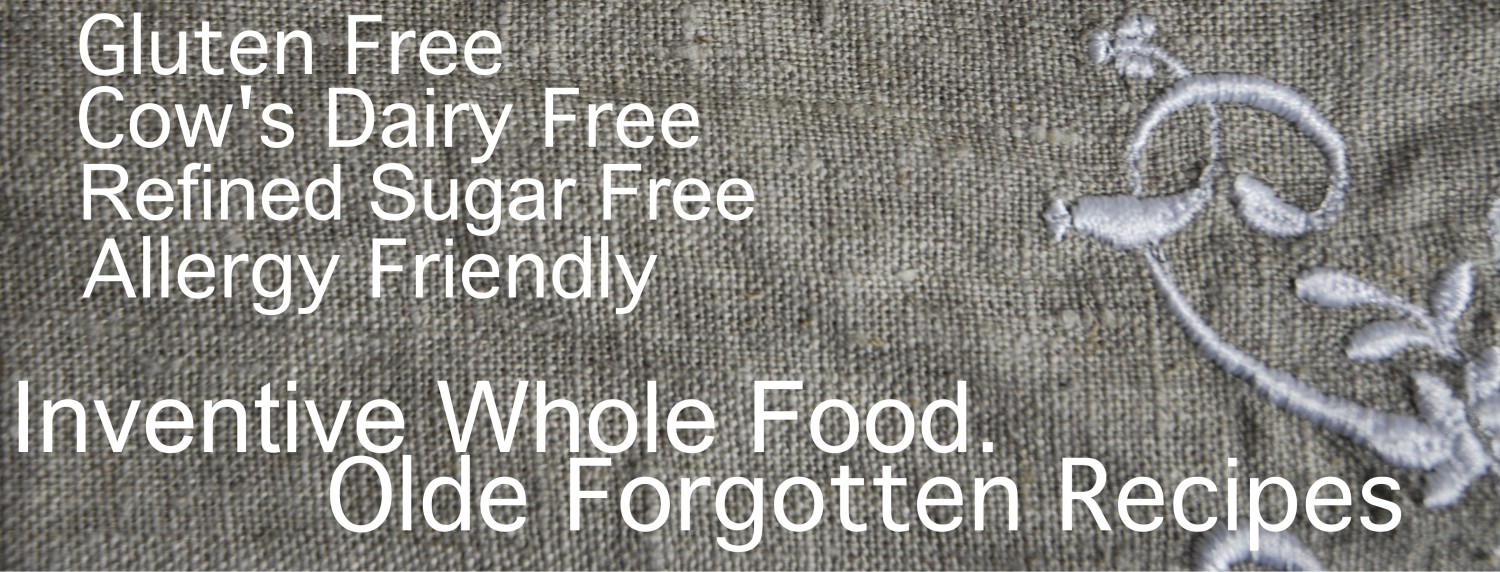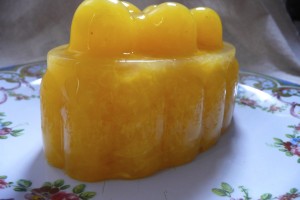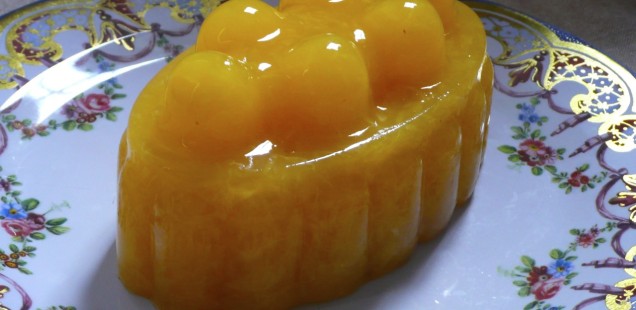
Cook: Orange Jelly and Apricot Jellied Oranges
“Christmas wouldn’t be Christmas without Orange Jelly”, writes a friend of Florence White’s from Yorkshire.
Oranges were introduced to England from Spain as early as 1290, but became a more prominent part of English food after Sir Walter Raleigh re-introduced them in the 16th Century. Apparently a family called the Carews, in Beddington, Surrey, cultivated them until a great frost in 1739-1740 destroyed them.
Orange Jelly has been substantially replaced by the American influence of Cranberry Sauce for the turkey. It can equally be served as a refreshing dessert on the Christmas table – light and healthy, but nonetheless with all the pomp the holiday deserves.
What I love so much about Florence White’s Orange Jelly recipe, is that, in her own words, it retains all its goodness, vitamins and nutritional value because the orange is included pulp and all.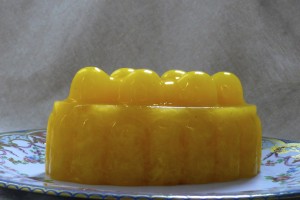
Florence proposes keeping the shells of the orange halves to fill with the jelly – this is just perfect for those of you who don’t have a fancy jelly mould. You can then slice up your set jelly orange-halves to serve as wedges – a little surprise on the plate.
This gave me an idea, inspired I admit in part by Heston Blumenthal’s brilliant Meat Fruit – his chicken liver parfait dressed up as a mandarin by a fine outer layer of delicate, aromatic mandarin jelly.
Apricot Jellied Oranges for the Australian Christmas table. Not nearly as clever, I’m the first to admit, as Meat Fruit (pure brilliance), but for a summer Christmas where Apricots will be in seasonal abundance, this twist on Orange Jelly will do a few neat things. It will provide the lovely bite in the sweetness like cranberry does. It will go perfectly with the turkey and the ham or even a meaty white fish if that is your summery Christmas table preference. But best of all, it will give your guests that little ping of surprise, so valuable at a party table – when they bite into their orange jelly and taste Golden Apricot. Gold.
Florence White doesn’t boil her sherry, but I’m replacing the sherry. Being a sweet wine, it’s hard to find sherry today without added sulfites. So I’m using Armagnac – and I’m going to boil out the alcohol briefly to make it more palatable for the children at the table.
I’m using carrageenan or Agar Agar (seaweed superfood) instead of gelatine – though for the record, I think gelatine’s great.
You could make jellies like these for a kids party using any fruit. Watermelon in pomegranate halves? Pomegranate and raspberry in watermelon rind?
I’ve also removed the sugar from the recipe as orange is sweet. I’ve just added one tablespoon of xylitol.
My children describe the taste as ‘sour’, as they gulp it down happily by the spoonful.
Clearly sweet enough!
For the apricot version, I would suggest keeping some extra sweetness.
Orange Jelly
Florence White’s ingredients include 4 oranges, loaf sugar, gelatine “a good weight” and sherry or masala, half a gill. What is a gill? I searched through her Conversions chapter to no avail! 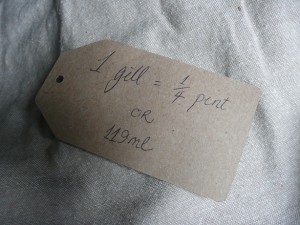
Preparation Time: 30mins
Cooking Time: 10 mins, plus 2 hours to set
Ingredients:
- 4 oranges
- water, 100ml
- Armagnac, 50ml
- xylitol 1 tbsp
- 1.5tbsp Vegeset or Agar Agar powder or ½oz of leaf gelatine (prepared as per packaging)
- juice of a lemon
- Wash and dry the oranges. Pare one and steep the peel in the Armagnac and half the water for 1 hour.
- Juice and Pulp the oranges, removing the white pith and as much of the stringy bits as you can.
- After an hour, drain the peel, pouring the liquid into a saucepan and discarding the peel. Add the remaining water and the spoonful of xylitol.
- Sprinkle the Vegeset or Agar Agar powder over the cold liquid, then bring to the boil slowly, stirring all the while to ensure it dissolves evenly in the liquid.
- Add the orange pulp and the orange and lemon juice. Stir until combined and just heated a little.
- Pour into your half-oranges (makes enough for 3 halves – 12 fine wedges) leaving enough to pour into your jelly mould.

- Set in the fridge or a cool place for 2 hours.
- Cut the orange halves into wedges and serve with your roast meat.
Turn the jelly out and place on the table with your roast meat or alternatively, save it for dessert!
Apricot Jellied Oranges
Preparation Time: 30mins
Cooking Time: 10 mins, plus 2 hours to set
- 12 large apricots, roasted for 20 mins at 180°, then mashed with a fork
- water, 100ml
- Armagnac, 50ml
- xylitol 1 tbsp
- rapadura (unrefined cane sugar) or honey, 2 tbsp
- 1.5tbsp Vegeset or Agar Agar powder or ½oz of leaf gelatine (prepared as per packaging)
- juice of a lemon
- juice of an orange
- emptied shells of 2 oranges
- Method:
- Place the armagnac, water and sugars in a saucepan, sprinkle with the Vegeset or Agar Agar powder while cold, then bring to the boil slowly, stirring all the while to ensure it dissolves evenly in the liquid.
- Add the mashed apricot, orange juice and lemon juice. Stir until combined and just heated a little. If you need more liquid, add some of the juice of the second orange.
- Pour into your half-oranges (makes enough for 4 halves – 12 wedges) leaving enough to pour into your jelly mould.
- Set in the fridge or a cool place for 2 hours.
- Cut the orange halves into wedges and serve with your roast meat.
Alternatively, makes a delightfully healthy after school treat for the children!
Leave me a comment below – I love it when I hear from you!
